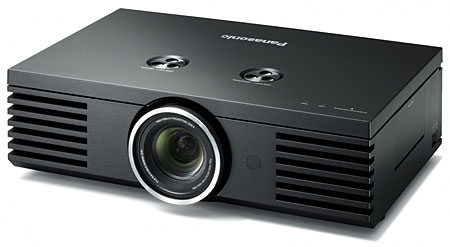Panasonic PT-AE2000U LCD Projector

Features
The PT-AE2000U follows the previous-generation PT-AE1000U and shares many of the earlier model's attributes, including its physical form. Each is housed in a big, black rectangular box with a center-mounted lens, and two leveling feet on the front and manual horizontal and vertical lens-shift wheels make it easy to place and orient the projector. Even better, it has motorized zoom and focus controls with very fine-step increments. The AE2000U sports three HDMI 1.3a inputs on the back, whereas the AE1000U had two HDMI 1.2 inputs.
The AE2000U retains Panasonic's Smooth Screen technology, which is designed to reduce the "screen-door effect" common to LCD projectors. At the heart of virtually all such projectors are three LCD imaging chips made by Epson—the only exception is Sony, which makes the chips for its own LCD projectors. The AE2000U uses the latest-generation D7 1080p chips with an inorganic alignment layer, which better resists degradation from exposure to ultraviolet light, and vertically aligned liquid crystals, which are said to improve the black level. The D7's aperture ratio—the ratio of each pixel's light-transmissive area to its total area—is 54%, up from 45% in the D6. This is still far less than the >90% aperture ratio of DLP and LCoS, which is why Panasonic developed its Smooth Screen technology.
One feature common to both models is how they display 1080p/24 material. When the projector receives such a signal, it repeats each frame four times, resulting in a refresh rate of 96Hz. This is fairly rare and welcome news for Blu-ray movie buffs, because it results in smoother motion than 1080p/24 displayed at 60Hz, which is a much more common scenario.
Another holdover is an integrated waveform monitor, which I've never seen on any other display. This lets you see exactly what the image is doing in terms of luminance levels in the luminance channel as well as the red, green, and blue channels. It also lets you look at single lines or the entire screen in each of the aforementioned channels. All of this is very helpful when adjusting the brightness and contrast settings.
Both models offer three gamma controls for the low, mid, and high ranges of brightness, allowing you to carefully adjust the transition from dark to light on the screen. Also available in the user menu are complete grayscale-calibration controls, which makes it easy for a qualified technician to calibrate the display.
The Color Management feature, also common to both projectors, lets you tweak specific colors on the screen. You put a cursor on the point whose color you want to adjust, and you can change the saturation, tint, and brightness of that color. Up to eight different colors can be saved in one of three user memories. I don't recommend trying this unless you have some tech chops—it's way too easy to screw things up.
Like many front projectors, the AE2000U and its predecessor provide a dynamic iris, which opens and closes according to the overall brightness of the image. The AE2000U's dynamic iris is said to have greater stability and finer increments in the speed with which it operates.
Among the touted improvements over the AE1000U is a new optical system and a Detail Clarity Processor. According to Panasonic's literature, this processor "analyzes frequency characteristics of each frame in three dimensions (horizontal, vertical, and along the time axis) and applies necessary sharpness at varying degrees to create natural, life-like images with exceptional clarity."
Another new feature in the AE2000U is Split Adjust mode, which lets you select a portion of the image that is then frozen and displayed twice, side by side, on the screen. As you adjust the picture controls, you can see their effect compared with the unaffected image.























































